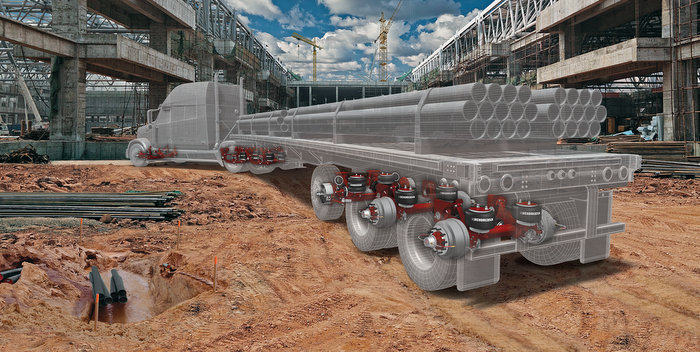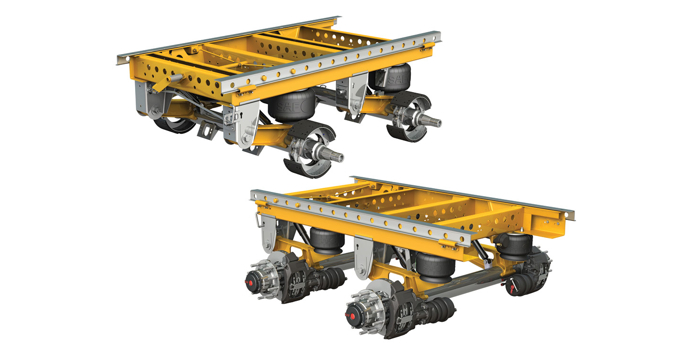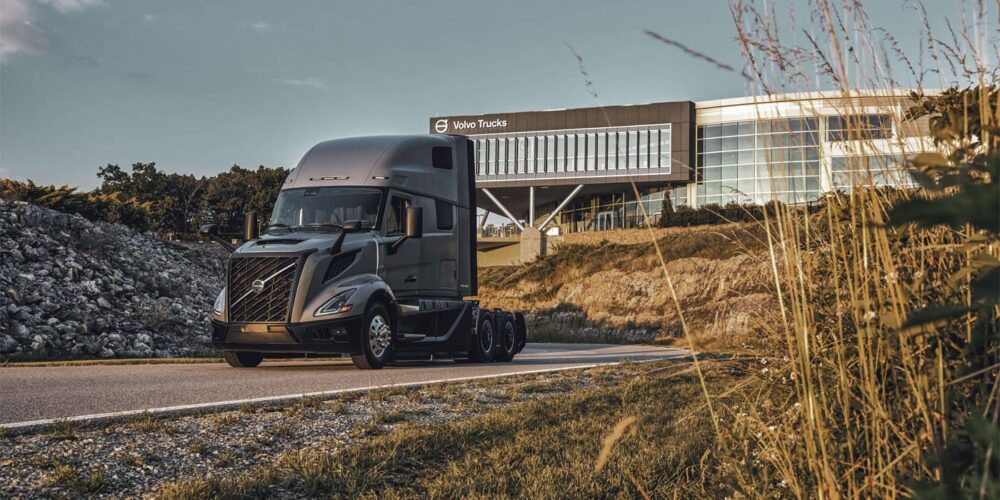Trailer suspensions are comprised of springs, dampers, shock absorbers, axles and other components that link the trailer to its wheels allowing the driver to have complete control of the trailer. In addition, they dampen harmful inputs from the road (vibrations, bumps, noise), giving drivers a smoother ride while protecting the trailer and its cargo.
However, safety and control of the trailer comes at the cost of lesser ability to dampen and absorb inputs from the road. That’s because the stiffness of the spring affects how the sprung mass—the mass of the trailer supported on the springs—responds. The stiffness is affected by the ratio between the sprung and unsprung mass—the weight of the axle, brake and wheel end systems. When a tire absorbs impact and bounces vertically, a loosely sprung suspension—or one where the sprung and unsprung mass are isolated—will better accept vertical movement and help dissipate the input. In that way, a high unsprung mass will dampen road input, and thus protect cargo, reduce noise and vibration and increase driver comfort.
Because of this dichotomy, suspension manufacturers have worked to achieve a balance in performance to provide driver comfort and cargo protection while maintaining safety and control of the trailer. This balance is further challenged by the fleet’s need for reduced total cost of ownership (TCO), operational simplicity and overall suspension system weight to carry more freight and reduce fuel and emissions.
“While safety is the suspension’s primary function for braking and maneuverability, cargo protection and trailer isolation from road inputs closely follows,” says Bill Hicks, trailer suspension systems—product planning, SAF-Holland.
Besides driver comfort, fleets want to spec a trailer suspension that reduces road input in order to prolong the life of the trailer’s components. Lights, doors and hinges, side walls and the suspensions itself are all affected by vibration and bumping.
“Trailer suspensions, regardless of design, provide an engineered level of compliance between the cargo and trailer components and the road inputs transmitted by the unsprung mass of the axle, brake and wheel end systems,” Hicks says. “The greater the isolation between the sprung and unsprung masses, the greater the life of all the trailer components due to reduced vibration and stress levels. In addition, the cargo protection level will be increased further reducing cargo damage claims and overall costs.”
The type of suspension system can determine ride characteristics. Air springs are known for smoother rides, says Keith McComsey, product line manager, Hendrickson vocational trailer products. However, with improvements in technology, the differences between air ride and mechanical springs are minimal in laden conditions.
Leaf springs are the simplest suspension systems as they typically don’t require an air control system and shock absorbers. According to Hicks, they will work best if the trailer and its application/duty cycle allows for half to full laden conditions for most of its life cycle.
Maximize tire investment
Trailer suspensions are interconnected to trailer wheel systems, making the suspension system critical to the life of trailer tires.
“The suspension must also manage the tire load/road impact profile to maintain a certain level of uniformity and consistency over all but the most adverse road conditions,” says Hicks. “Maintaining a consistent tire footprint improves braking performance and will reduce tire wear.”
“Tires wear best when they are loaded evenly and consistently across the tire tread,” says Jim Rushe, product line manager at Hendrickson on-highway trailer products. “A trailer air suspension, in combination with good suspension damping, helps the tires to remain in contact with the road and promote even tire wear. Additionally, air suspensions automatically provide an even distribution of the trailer load across all tires, regardless of the location of the load in the trailer. This prevents premature tire wear that can occur when one axle carries a higher load than the other(s).”
Fleet managers should not only configure the trailer suspension to provide uniform trailer tire wear, but also the trailer tires should be checked for signs of non-alignment wear. These conditions can be fixed with an alignment of the trailer’s axles.
“All suspension types incorporate some form of axle alignment capabilities to facilitate proper tire alignment,” Hicks says.
Determining type
No different from spec’ing the trailer itself, the application determines the type of suspension mounting is needed. This, in addition to capacity, will determine which suspension is required.
“Air ride suspension market share for fixed frame, specialty trailers is high since the added trailer cost, application demands and customer preferences require a higher level of ride quality/cargo protection in on/off-highway applications. Off-road specialty trailers are still dominated by mechanical suspensions due to their simplicity and robustness,” Hicks offers. “Today’s on-highway dry freight van trailers, however, typically run a fair split between air and mechanical suspensions as overall TCO is more time frame limited for a fleet manager to consider. With the advent of advanced communications systems, running an unladen trailer has been greatly reduced over the percentage of a trailer’s life, thus making mechanical suspensions as viable as air.”
Most major suppliers will have suspension application checklists or forms to complete to identify the key metrics needed to select the right suspension. By working with suppliers, fleets will consider capacity, loads, Bridge Formula laws, area of operation and geography when choosing a trailer and its suspension system.
“Fixed suspension installations may be welded into place on the trailer or bolted onto the trailer. The suspension capacity is determined by the anticipated trailer cargo loads, as well as the legal allowable axle load. Other factors considered for suspension capacity include: The trailer duty cycle; area of operation; road conditions; and/or the number of axles on the trailer. These may require an increase in suspension rated capacity for rougher applications in order to provide a more durable suspension system. Higher axle loads can also impact the type of brake lining that is needed or the wheel equipment that can be used,” Hendrickson’s Rushe comments.
As an example, Rushe points out that fleets with diminishing loads would need to look into the unique challenge of handling varying unsprung mass.
“A typical leaf spring suspension will transmit most of the road inputs into the trailer when the trailer is empty or lightly loaded. Those inputs can be reduced as the trailer load increases,” Rushe says.
Therefore, suspension components may be spec’d differently to work better with the trailer’s suspension and balance unsprung mass.
Mechanical steel spring type suspensions can offer fleet owners options that are more lightweight. Composite spring designs are viable lightweight options that can take the place of heavier steel springs and still protect the trailer and its cargo.
For air suspensions, the suspension set-up must be within the manufacturer’s specifications. Ride height is key and can impact an air suspension’s ride quality performance.
“If ride height is set too low, the air spring may impact its internal bumper and transmit loads into the trailer. If the ride height is set too high, it can result in a stiffer suspension that will reduce the suspension’s ability to isolate the trailer from the road,” Rushe says.
Fleets operating specialty trailers (i.e. tank, platform, bulk) have an additional set of concerns when spec’ing suspensions. For any specialty application, reviewing the application with the suspension supplier will help to achieve an understanding of what options are available, and it will allow the fleet to benefit from the experiences the suspension supplier has had in similar applications.
“Specialty trailers, are higher cost trailers than a typical dry freight van due to their specific vocational design intent, the level of hardware required on the trailer to accomplish this task, and the expected longer service life,” Hicks says.
Hendrickson’s Rushe lists the following as additional considerations for tank, platform and bulk applications:
• Permissible axle loads;
• The quality of the road surface should. Roads that are generally rougher, or roads that can be rougher in certain seasons, may dictate that a higher capacity suspension should be used;
• The anticipated ratio of improved/unimproved roads (or off-road use);
• Higher CG trailer loads may also require a specific suspension type, especially when operating to a high degree on curvy roads; and
• The number of axles used on a trailer, their position on the trailer, or if used in multi-trailer combinations (such as pup trailers, B-trains, etc.).
As always, it’s important to evaluate customer’s needs versus the total cost of ownership when making these choices.
Additionally, the methods used for loading and unloading the trailer may also point to the use of suspension options that can extend the life of the suspension components.
“To improve during loading and unloading situations, air ride trailer suspensions also have the ability to exhaust air and lock the deck height in place,” Rushe says.
And as mentioned earlier, total cost of ownership must always be a consideration.
“Suspension systems suppliers offer many value added options which can offer a better total cost of ownership return even if the initial purchase price is higher,” Hicks says. “Fleet managers need to understand which components are most critical to their overall operations and investigate which options are available.”















